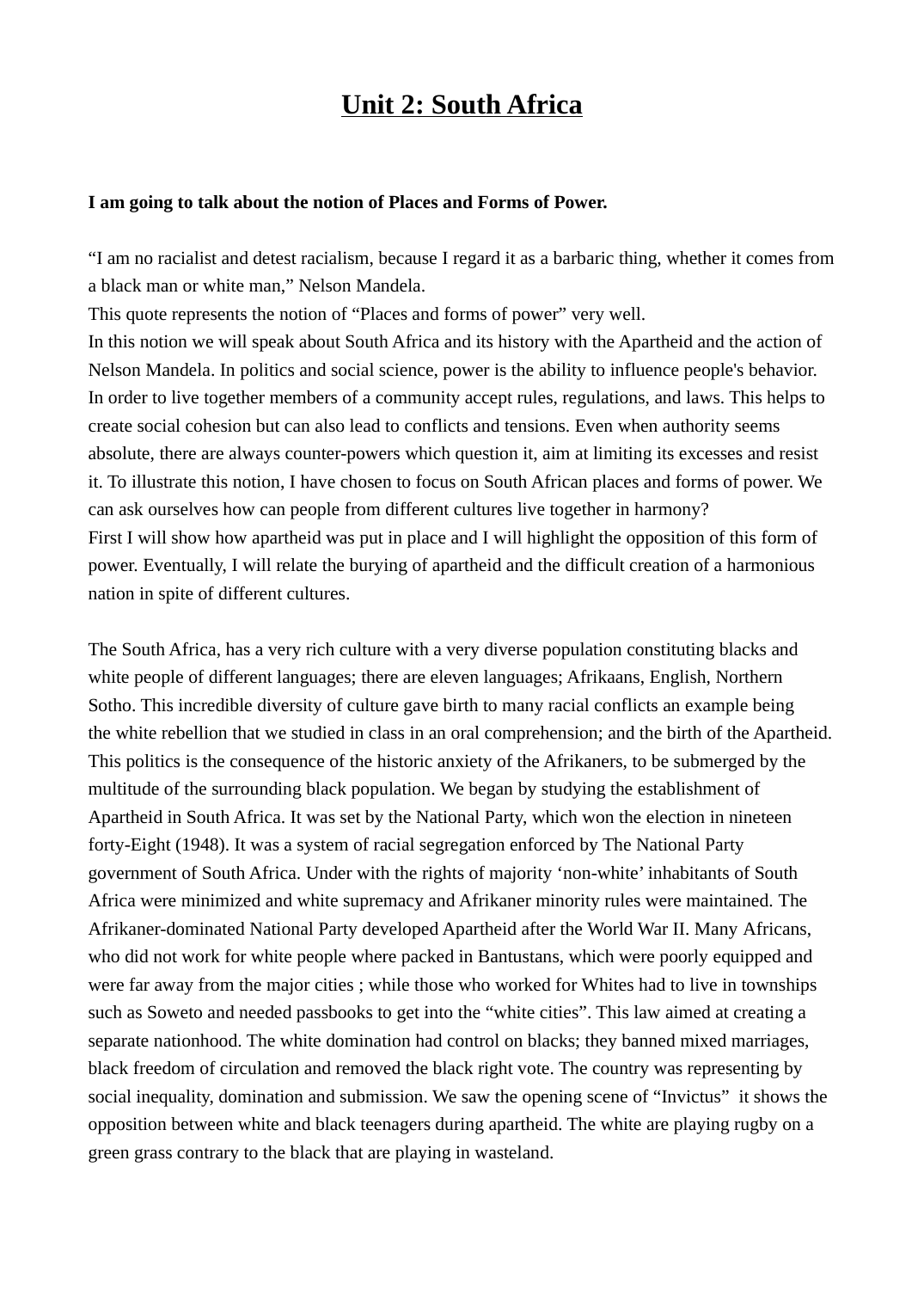power
Publié le 23/05/2020

Extrait du document
«
Unit 2: South Africa
I am going to talk about the notion of Places and Forms of Power.
“I am no racialist and detest racialism, because I regard it as a barbaric thing, whether it comes from
a black man or white man,” Nelson Mandela.
This quote represents the notion of “Places and forms of power” very well.
In this notion we will speak about South Africa and its history with the Apartheid and the action of
Nelson Mandela.
In politics and social science, power is the ability to influence people's behavior.
In order to live together members of a community accept rules, regulations, and laws.
This helps to
create social cohesion but can also lead to conflicts and tensions.
Even when authority seems
absolute, there are always counter-powers which question it, aim at limiting its excesses and resist
it.
To illustrate this notion, I have chosen to focus on South African places and forms of power.
We
can ask ourselves how can people from different cultures live together in harmony?
First I will show how apartheid was put in place and I will highlight the opposition of this form of
power.
Eventually, I will relate the burying of apartheid and the difficult creation of a harmonious
nation in spite of different cultures.
The South Africa, has a very rich culture with a very diverse population constituting blacks and
white people of different languages; there are eleven languages; Afrikaans, English, Northern
Sotho.
This incredible diversity of culture gave birth to many racial conflicts an example being
the white rebellion that we studied in class in an oral comprehension; and the birth of the Apartheid.
This politics is the consequence of the historic anxiety of the Afrikaners, to be submerged by the
multitude of the surrounding black population.
We began by studying the establishment of
Apartheid in South Africa.
It was set by the National Party, which won the election in nineteen
forty-Eight (1948).
It was a system of racial segregation enforced by The National Party
government of South Africa.
Under with the rights of majority ‘non-white’ inhabitants of South
Africa were minimized and white supremacy and Afrikaner minority rules were maintained.
The
Afrikaner-dominated National Party developed Apartheid after the World War II.
Many Africans,
who did not work for white people where packed in Bantustans, which were poorly equipped and
were far away from the major cities ; while those who worked for Whites had to live in townships
such as Soweto and needed passbooks to get into the “white cities”.
This law aimed at creating a
separate nationhood.
The white domination had control on blacks; they banned mixed marriages,
black freedom of circulation and removed the black right vote.
The country was representing by
social inequality, domination and submission.
We saw the opening scene of “Invictus” it shows the
opposition between white and black teenagers during apartheid.
The white are playing rugby on a
green grass contrary to the black that are playing in wasteland..
»
↓↓↓ APERÇU DU DOCUMENT ↓↓↓
Liens utiles
- Le soft power, l’autre versant de l’expression de la puissance des États
- Work Energy & Power
- ART AND POWER
- Article - The power of words - Words, a powerful political and social weapon ?
- Qu'est-ce que le soft power et sur quels éléments repose-t-il?


